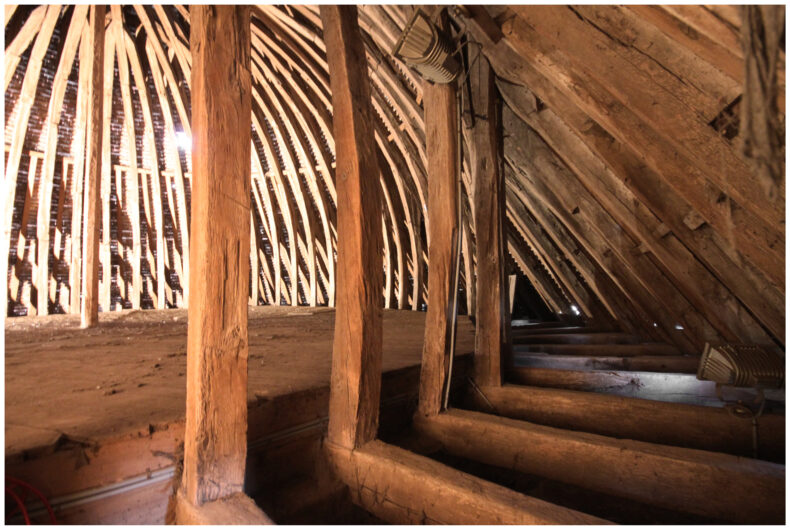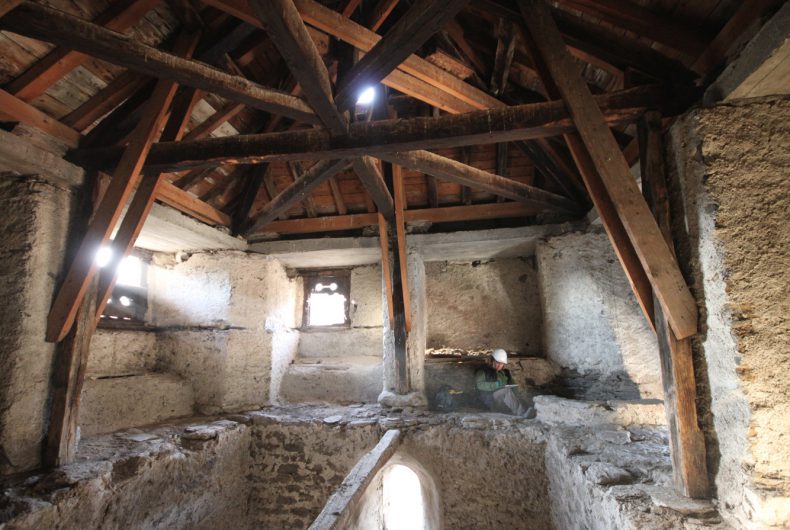
ARCHITECTURAL WOOD REFERENCES
The archaeodendrometric study (wood identification, tree-ring dating, dendromorphology, wood traces analysis) of architectural timbers aims to provide new elements of authentication (date and phase of felling of the trees used, availability of timber, highlighting of restoration/modification phases), to understand the biogeographical origin of the trees, but also to provide information on their technical construction (method of cutting and shaping the timbers…). On-site work can be carried out at the same time as the restoration teams (carpenters, joiners, conservators), or beforehand in order to provide precise and decisive chronological data on the construction periods of the structures in place and to be preserved.
Frames for the side aisles of the Saint Jean church in Joigny (89)
The results of the dendrochronological study carried out on the frameworks of the apse and side aisles of the church of Saint Jean in Joigny (Burgundy) show that the oaks were felled during the vegetation rest period of 1757-1758, 1759-1760 and 1782-1783. The traces and markings found on the timbers also attest to the contemporaneity of the pieces used in each of the three structures; pieces squared with a pit saw and a bleaching axe/sheep’s shoulder.
Collaboration : Cabinet d’architecture Agence 8 Boucaud / Paris – Service des Bâtiments de la Ville de Joigny (Bourgogne)


Tithe Barn, Chatillon sur Loire (45) - 12th century
The archaeodendrometric study carried out on the timbers of the rafters forming the trusses of the former Protestant temple has revealed an authentic hidden framework from 1186, also identifying the presence of an ancient vault panelled in beech (Fagus silvatica).
Lourdeault Tower, Semur-en-Auxois (21) - 13th century
The precision of the dendrochronological dates obtained on the three levels of the ceiling and the framework, define the chronological dimension of the construction site of the tower, erected in the space of a few months during the summer of 1274, from reserve oaks felled and wrought between early spring and early summer.
Collaborations: Society of Historical and Natural Sciences, LP3 Conservation workshop


Mercoeur Tower, Blesle (43) - 15th/20th centuries
Complex and multiple, the internal structures of the tower bear witness to numerous architectural modifications that needed to be characterised and dated chronologically by means of archaeological surveys, wood dating, mortar studies, etc.
Collaborations: Heritage Architects, Regional Conservation of Historic Monuments
Ceilings with bestiary, Metz (54) - 13th century
A detailed examination of the 200 boards revealed that a dozen oak trees were felled during the autumn-winter of 1218-1219, then immediately “opened” by tangential splitting. Profiled in barley grain and juxtaposed as quickly as possible, the planks thus perfectly fulfilled their function as a ceiling intended to receive the polychrome decoration.
Location: Museum de la Cour d’Or – Metz Métropole (France)


Winery and press, Morey-Saint-Denis (21) - 16th and 19th centuries
The buildings of the old winery, which belonged to the former abbey of Tart-le-Haut until the Revolution, still have a framework on supporting posts (erected in 1519) as well as an exceptional example of a wine press modified during the 18th and 19th centuries.
Collaborations: LP3 Conservation workshop, Dulion Carpenter Corporation
Tie-rods from the church of Saint Germain des Prés, Paris (75) - 12th century
The combination of radiometric analysis (carbon 14C) and tree-rings dating of the remains of oak tie-rods, still lodged in the piers of the church’s chevet, have made it possible to specify the period of installation of these timbers, which were intended to support the scaffolding and the arches of the voussoirs.
Collaboration: Department of Heritage and History Paris, Regional Conservation of Historic Monuments


Château de Brabois, Villers-les-Nancy (54) - 19th century
One of the staircases consists of a French-style stringer made up of a succession of assembled curved pieces. The technical study and the records of tool marks taken show a 19th century design, confirmed by the date of felling of the timbers dating back to the autumn-winter of 1826-1827.
Collaboration: Regional Conservation of Historic Monuments
Woodwork, Puttelange-aux-Lacs chapel (57) - 18th century
The major restoration work carried out on the woodwork provided an opportunity to carry out surveys of the carved wood used, concluding that only multi-century-old Moselle oak, felled during the autumn-winter of 1771-1772, was used.
Collaboration: Regional Conservation of Historic Monuments , Leriche workshop


